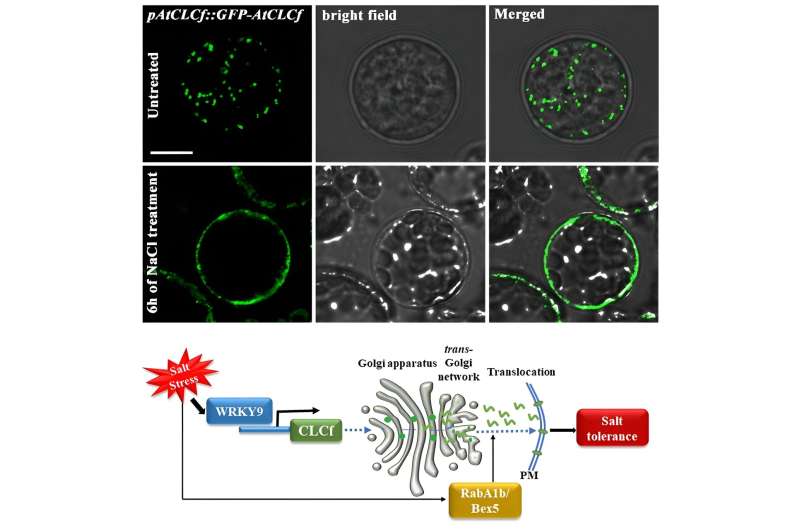This article has been reviewed according to Science X's editorial process and policies. Editors have highlighted the following attributes while ensuring the content's credibility:
fact-checked
peer-reviewed publication
trusted source
proofread
Biologists discover a previously unknown salt tolerance mechanism in plants

Researchers from the National University of Singapore (NUS) have discovered a salt adaptation mechanism in plants that facilitates chloride removal from the roots and enhances salinity tolerance. The work was published in the journal Nature Communications.
Soil salinity is one of the most deleterious environmental stress factors and increased salinity poses a growing challenge for crop production and adversely affects crop yields worldwide. The excess accumulation of soluble salts, especially sodium chloride (NaCl), in the root zone severely impedes plant growth, reducing crop productivity. Although chloride ions (Cl–) are essential nutrients for plants at low concentrations, their excessive accumulation is toxic to the plant cells.
Plants have evolved various strategies to cope with such environmental stresses by employing various channels and transporters for maintaining ion balance (ion homeostasis) in their cells. While there is a better understanding of the sodium ion homeostasis under salt stress, removal of chloride ions is not well understood.
To address this, a research team led by Professor Prakash Kumar from the Department of Biological Sciences, NUS has uncovered a novel mechanism of plant adaptation to salt stress involving the NaCl-induced translocation of a specific chloride channel protein, AtCLCf.
Their work revealed that the AtCLCf protein is made and stored in the endomembrane system (the Golgi apparatus) under normal growth conditions. When the root cells are treated with salt, AtCLCf translocates to the plasma membrane (PM), where it helps to remove the excess chloride ions. This represents a novel mechanism to increase the plant's salinity tolerance.
The research is a collaboration with Dr. Jiří Friml from the Institute of Science and Technology, Austria and Professor Xu Jian from Radboud University, The Netherlands.
The study also identified a transcription factor, AtWRKY9, that directly regulates the expression of the AtCLCf gene when the plant is under salt stress.
NaCl causes the AtCLCf protein to move from inside the cell (the Golgi) to the cell surface with the help of another protein called AtRABA1b/BEX5. If this movement is blocked by an inhibitor (brefeldin-A) or by modifying the BEX5 gene, it results in high salt sensitivity in plants.
Transgenic plants designed to produce additional AtCLCf gene showed increased salt tolerance in mutant forms of Arabidopsis plants lacking the CLCf gene. Collectively, these findings proved that AtCLCf is involved in the removal of excess chloride ions from root tissues to increase the salt tolerance of plants.
In order to understand how AtCLCf functions in plant cells, the researchers used several techniques such as fluorimetric measurement of liposomes incorporated with recombinant AtCLCf protein and chloride ion sensitive dye, as well as electrophysiological studies (patch clamp). These studies showed that AtCLCf works like a pump that swaps chloride ions with hydrogen ions, helping to remove excess chloride ions from the cells.
Prof Kumar said, "This represents an essential and previously unknown salt tolerance mechanism in Arabidopsis plants. This knowledge could be used to improve the salinity tolerance of crop plants in the future."
More information: Sivamathini Rajappa et al, The translocation of a chloride channel from the Golgi to the plasma membrane helps plants adapt to salt stress, Nature Communications (2024). DOI: 10.1038/s41467-024-48234-z
Journal information: Nature Communications
Provided by National University of Singapore





















